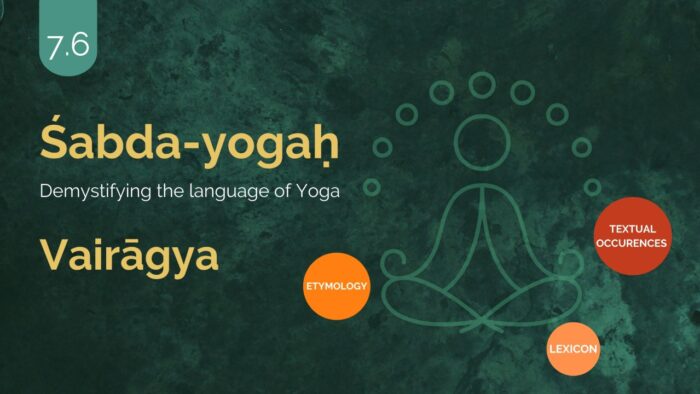Introduction
In this series, Yogic terminologies will be taken up and their -
- Etymological analysis,
- Lexical descriptions and
- Textual occurrences in Yogic literature and their commentaries, as available, will be presented. And finally observations will be made on the references.
Three texts - Yogasūtra, Haṭha-yoga-pradīpikā and Bhagavad-gītā are consulted for textual occurrences portion.
Śabda-yoga is intended to help students, teachers, and professionals of Yoga to develop a sound grammatical, contextual, and thereby an authentic and immersive understanding of Yoga terminologies.
7.6 Vairāgya
| Words of Unit 7 | |
| 7.1 | Abhāva |
| 7.2 | Pratyaya |
| 7.3 | ālambana |
| 7.4 | Viṣaya |
| 7.5 | abhyāsa |
| 7.6 | vairāgya |
Etymology
विराग+ ष्यञ्= वैराग्यम्
virāga+ ṣyañ= vairāgyam
This is a derivative noun.
virāga is the base noun that means being bereft of passion/desire
ṣyañ is the suffix that means भाव – the state – The suffix is added based on the grammatical rule गुणवचनब्राह्मणादिभ्यः कर्मणि च guṇavacanabrāhmaṇādibhyaḥ karmaṇi ca (Ashtadhyayi 5.1.124)
The derivative statement is - विरागस्य भावः वैराग्यम् virāgasya bhāvaḥ vairāgyam – the state of being bereft of passion/desire
Lexicon - There is no entry in the amarakosha
Textual Occurrences
Yogasūtra
There are three occurrences of the term Vairāgya in Yogasūtras. They are as follows -
अभ्यासवैराग्याभ्यां तन्निरोधः ॥ १.१२ ॥
दृष्टानुश्रविकविषयवितृष्णस्य वशीकारसंज्ञा वैराग्यम् ॥ १.१५ ॥
तद्वैराग्यादपि दोषबीजक्षये कैवल्यम् ॥ ३.५० ॥
abhyāsavairāgyābhyāṃ tannirodhaḥ .. 1.12 ..
dṛṣṭānuśravikaviṣayavitṛṣṇasya vaśīkārasaṃjñā vairāgyam .. 1.15 ..
tadvairāgyādapi doṣabījakṣaye kaivalyam .. 3.50 ..
Sūtra 1.12 mentions that the twin methods of Abhyāsa and Vairāgya are essential towards achieving citta-vṛtti-nirodha. Sūtra 1.15 defines Vairāgya as detachment/dispassion from objects of pleasure perceived here and those that are promised in the scriptures. It is also indicated that such a dispassion should reach a very high level (vaśīkārasaṃjñā). It is to be noted that this sūtra mentions the apara vairāgya – the lower vairāgya. The higher vairāgya or the para vairāgya is described in Sūtra 1.16 which is detachment in the workings of the three Guṇas. Though the word Vairāgya is not used in the sūtra 1.16, it discusses the higher vairāgya that propels a practitioner to the highest state of Samādhi – Nirbīja Samādhi.
Sūtra 3.50 states that by developing vairāgya from the outcomes of saṃyama (dhāraṇā-dhyāna-samādhi) mentioned in the previous sūtra (3.40) which is – ability to control all and ability to know everything – the seed of kleśas which are already in the state of burnt seeds, will get dissolved into their cause and the state of Kaivalya remains for the pure consciousness.
Bhagavadgītā
There are three references to the term Vairāgya in Bhagavadgītā. They are found in chapters 6, 13 and 18. They are as follows -
असंशयं महाबाहो मनो दुर्निग्रहं चलम् ।
अभ्यासेन तु कौन्तेय वैराग्येण च गृह्यते ॥ ६.३५ ॥
इन्द्रियार्थेषु वैराग्यमनहङ्कार एव च ।
जन्ममृत्युजराव्याधिदुःखदोषानुदर्शनम् ॥ १३.८ ॥
विविक्तसेवी लघ्वाशी यतवाक्कायमानसः ।
ध्यानयोगपरो नित्यं वैराग्यं समुपाश्रितः ॥ १८.५२ ॥
asaṃśayaṃ mahābāho mano durnigrahaṃ calam .
abhyāsena tu kaunteya vairāgyeṇa ca gṛhyate .. 6.35 ..
indriyārtheṣu vairāgyamanahaṅkāra eva ca .
janmamṛtyujarāvyādhiduḥkhadoṣānudarśanam .. 13.8 ..
viviktasevī laghvāśī yatavākkāyamānasaḥ .
dhyānayogaparo nityaṃ vairāgyaṃ samupāśritaḥ .. 18.52 ..
In the context of Dhyāna yoga in verse 6.35 Abhyāsa and Vairāgya have been stated as the means to reduce the distractions of the mind & regulate it. In verse 13.8 Vairāgya on the objects of the senses is spoken as one among the qualities that are essential to attain the knowledge of kṣetrajña (the knower of the field/the consciousness). In verse 18.52 to attain the highest limit of knowledge (realization of the consciousness) among other practices Vairāgya is also enumerated.
Haṭhayogapradīpikā - The term Vairāgya is not found in this text.
Tabulation of Textual References
|
Vairāgya |
Yogasūtra
3 references |
Bhagavadgītā
3 references |
Haṭhayogapradīpikā
- |
| Chapter 1 Sūtras 12, 15
Chapter 3 Sūtras 50
|
Chapter 6 Verse 35
Chapter 13 Verse 8 Chapter 18 Verse 52
|
- |
Observations
The following can be noted from the above references –
1) Vairāgya along with Abhyāsa are common to both Bhagavadgita and Yogasūtras
2) The two levels of Vairāgya – Para and Apara are discussed in the Yogasūtras.
3) As evident from the references above - from regulating & controlling the mind to the realization of the consciousness - Vairāgya has role to play
4) It is interesting to note that the terminology Vairāgya is not mentioned in Haṭhayogapradīpikā.
References:
- Advaitaśāradā - https://advaitasharada.sringeri.net/
- Amarakoṣasampat - http://amara.aupasana.com/
- Aṣṭādhyāyī - https://ashtadhyayi.com/
- Aksharamukha - https://aksharamukha.appspot.com/
- Avyayakośaḥ, śrīśrīvatsāṅkācāryaḥ, saṃskṛtavidyāsamitiḥ, chennai, 2004
- Gītā Supersite - https://www.Gītāsupersite.iitk.ac.in/
- Nāmaliṅgānuśāsana alias amarakoṣa of amarasiṃha with the commentary vyākhyāsudhā or rāmāśramī by bhānuji dīkṣita, Edited with notes by M.M.Pandit Shivadatta Dadimatha, Chaukhamba Saṃskṛta Prathisthan, Delhi, Reprint 2002
- śabdārthakaustubha, cakravartī śrīnivāsagopālācārya, Vol 4, Bappco Publication, Bengaluru, Reprint 2009
- Yoga-vaiśāradī - https://kymyogavaisharadi.org/
Unit 8 To be started…





